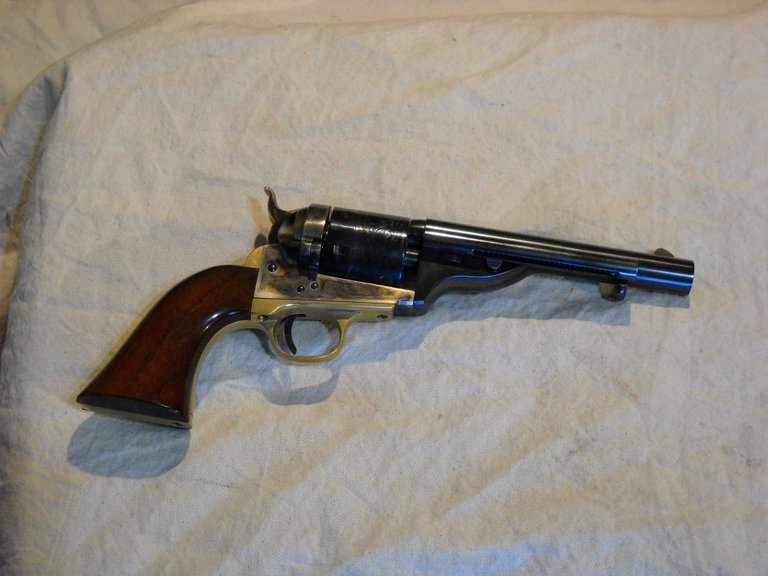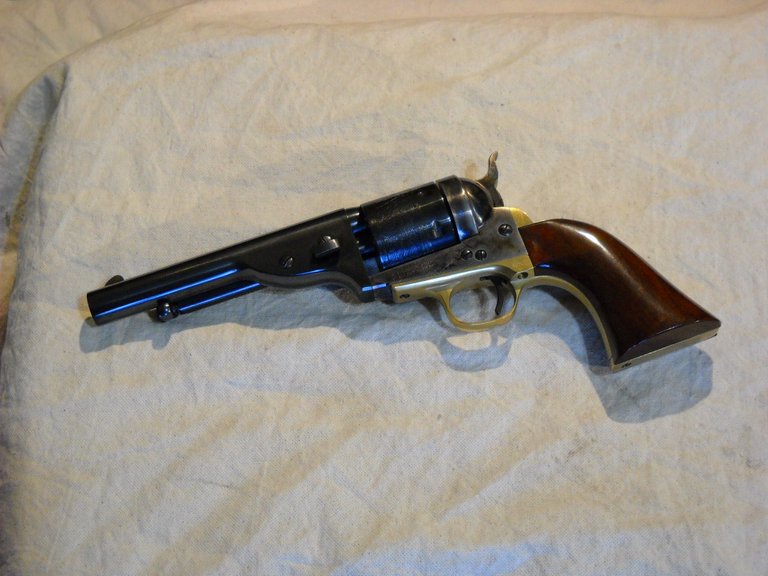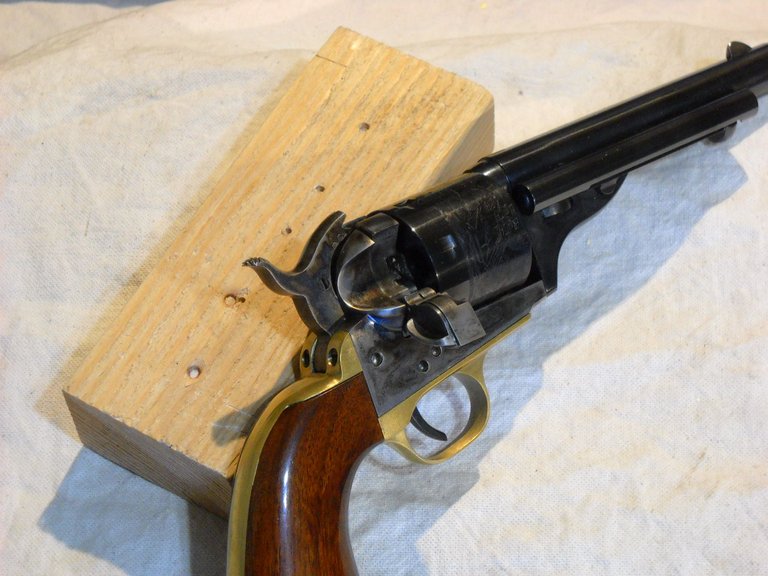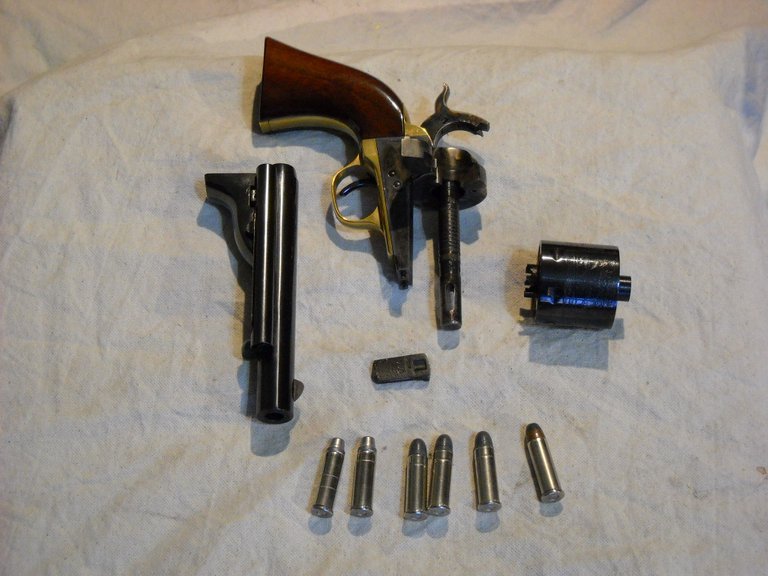Hello to all of you steemit people!
This post is about my 1871 Richards-Mason Colt cartridge conversion revolver as reproduced by A. Uberti, one of the most well known names in reproduction firearms from the "old west"period. This revolver is a copy of a cartridge conversion of the 1860 Army cap and ball revolver. I bought this revolver new about 10 or so years ago.
The 1860 and 1861 Colt revolvers were the primary pistols used by the Union army during the Civil War, but by the end of the Civil War, it was obvious to the military that cartridge loaded weapons were going to make the cap and ball revolvers obsolete. Several developments were made to convert the Colt revolvers to cartridge, both in rim fire cartridges and in center fire cartridges. Some of the .44 caliber revolvers were converted to use the .44 Henry rimfire, a cartridge that been around since the early days of the Civil war. Different cartridges were developed for the revolvers for the .44 caliber, the .36 caliber, and the .31 caliber Colt revolvers. Smith and Wesson had their own cartridges, having built the first cartridge revolvers before the start of the Civil War in .22 short caliber. However, that is a story for another day.
Eventually these developments led to Colt designing and manufacturing the 1873 Colt revolver, the famous "peacemaker" revolver in .45 Colt, and other calibers. Before the 1873 was ready to be manufactured, Colt was manufacturing cartridge versions of the 1860 Army, in .44 caliber, the 1861 Navy in .38 caliber, and also using most of the parts from the 1851 army and navy revolvers to make cartridge revolvers. There were 3 primary conversions used, along with other conversions being done to cap and ball revolvers by gunsmiths using the same types of systems. There was the Mason conversion, the Richards-Mason conversion, and the Colt factory designed 1872 "open top revolver, manufactured with many parts designed specifically for that revolver. Most of the earlier cartridge conversions used existing parts that had been manufactured for the cap and ball guns.
The revolver that I have is the 1871 Richards-Mason conversion revolver. The one I have is chambered for the .38 special, which is not period correct for the conversion, but works well in the revolver. The originals used the .38 short Colt cartridge, which is shorter than the .38 special, and not as powerful. The 1871 revolver used the same frame and internal parts as the cap and ball revolvers, but had new barrels and cylinders manufactured for them, as well as the cylinder back plate with the loading gate, and the spring loaded plunger for pushing the empty cases out of the cylinder when reloading.
So, let's take a look at the revolver.
This is a closer picture of the revolver with the loading gate open. For loading, you would pull the hammer back to the first notch, this would free the cylinder to turn it by hand. You turned the cylinder to line up each chamber with the opening normally covered by the loading gate, drop a cartridge into the chamber, and then turn the cylinder to the next chamber. To unload the cylinder, you would start the same way, and when you line the chamber up with the opening, you push the plunger rod into the cylinder from the front to push the cartridge out. Then, simply reload that chamber and rotate the cylinder to the next chamber.
These revolvers shot black powder cartridges, which caused powder fouling and if left uncleaned would cause corrosion. The conversion Colts disassemble the same way as the cap and ball guns do, they're much easier to clean when disassembled. There is a relatively large diameter rod that is mounted to the frame of the revolver that the cylinder rides on, normally called the cylinder pin. In these open frame revolvers, the pin was large because the barrel was also mounted to this pin and held in place with a wedge. It may seem a bit crude by today's standards, and perhaps a weak point, but these guns were designed for black powder, and were strong enough for the purpose.
To disassemble the revolver for cleaning, you remove the wedge from the barrel and pull the barrel foreward off the cylinder pin. The cylinder slides off the pin, and it's ready to be cleaned. These revolvers can be further disassembled, but it's not necessary when shooting smokeless ammo. This is what the various parts look like when disassembled.
You can see the slot in the end of the cylinder pin that the wedge goes through to hold the barrel in place. Also, you can see that the firing pin is mounted to the hammer on this version of the revolver. On some of the other conversion types, the firing pin was mounted in the cylinder back plate, allowing for the use of the original cap and ball hammer. This was a useful feature back then because it allowed a person to use the cap and ball parts if cartridges became hard to find.
Because the originals were less expensive than the 1873 revolvers, the conversion pistols stayed in use for most of the rest of the 1800s by civilians.

This is the end of this post, I hope you enjoyed it!
Next time, we'll be taking a look at another revolver in my collection.
If you like my posts, be sure and upvote the post, and follow me for more posts like this one.




Congratulations! This post has been upvoted from the communal account, @minnowsupport, by Amber-yooper (about that bass) from the Minnow Support Project. It's a witness project run by aggroed, ausbitbank, teamsteem, theprophet0, someguy123, neoxian, followbtcnews, and netuoso. The goal is to help Steemit grow by supporting Minnows. Please find us at the Peace, Abundance, and Liberty Network (PALnet) Discord Channel. It's a completely public and open space to all members of the Steemit community who voluntarily choose to be there.
If you would like to delegate to the Minnow Support Project you can do so by clicking on the following links: 50SP, 100SP, 250SP, 500SP, 1000SP, 5000SP.
Be sure to leave at least 50SP undelegated on your account.